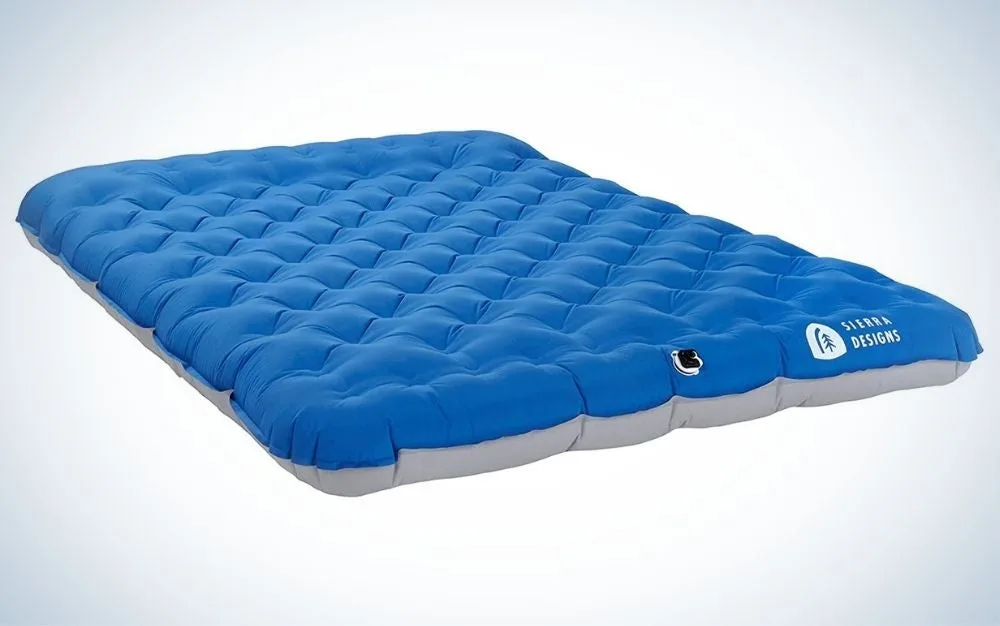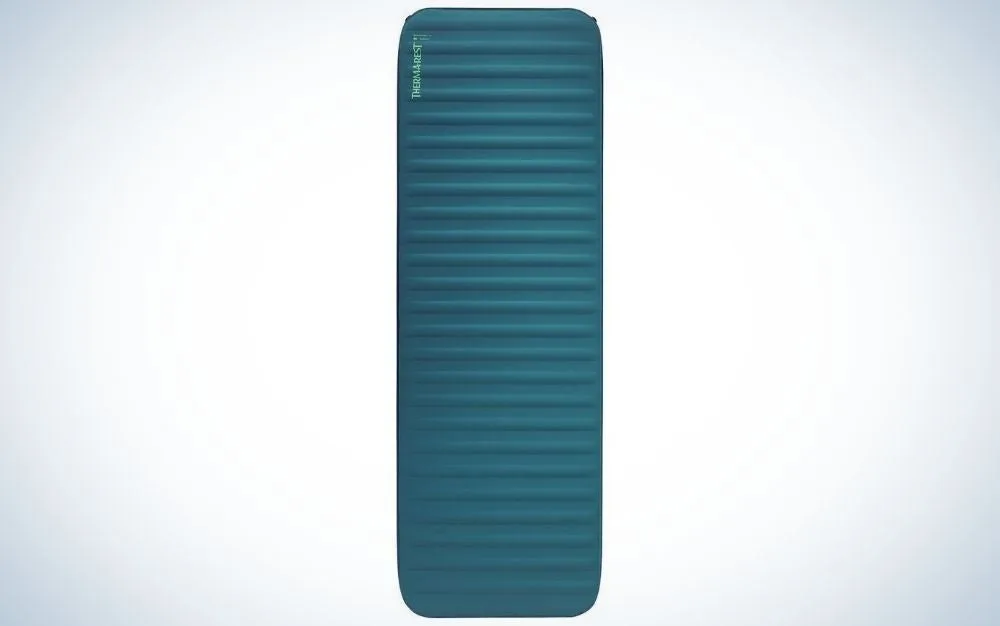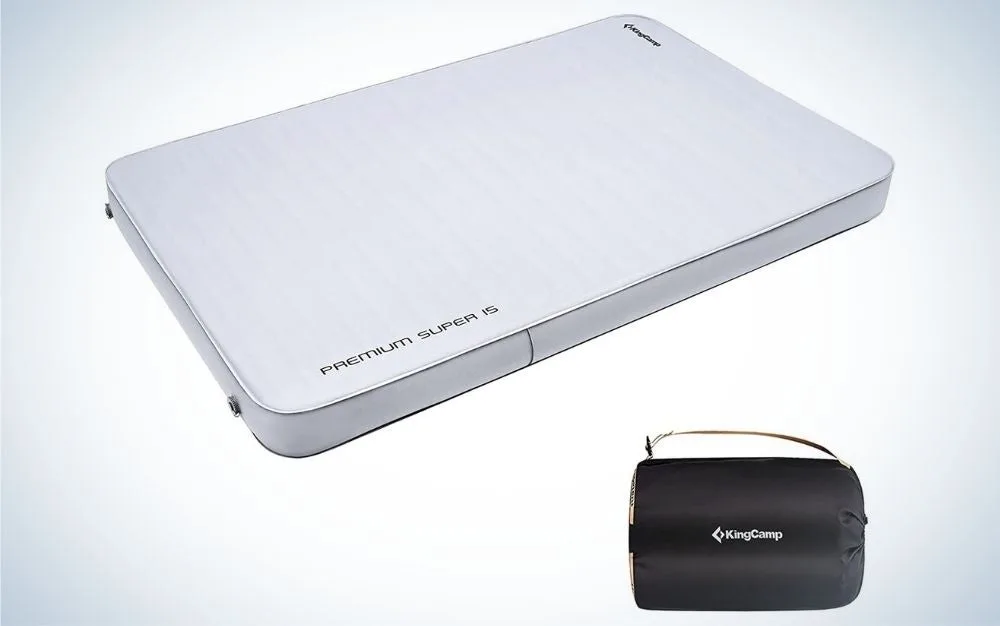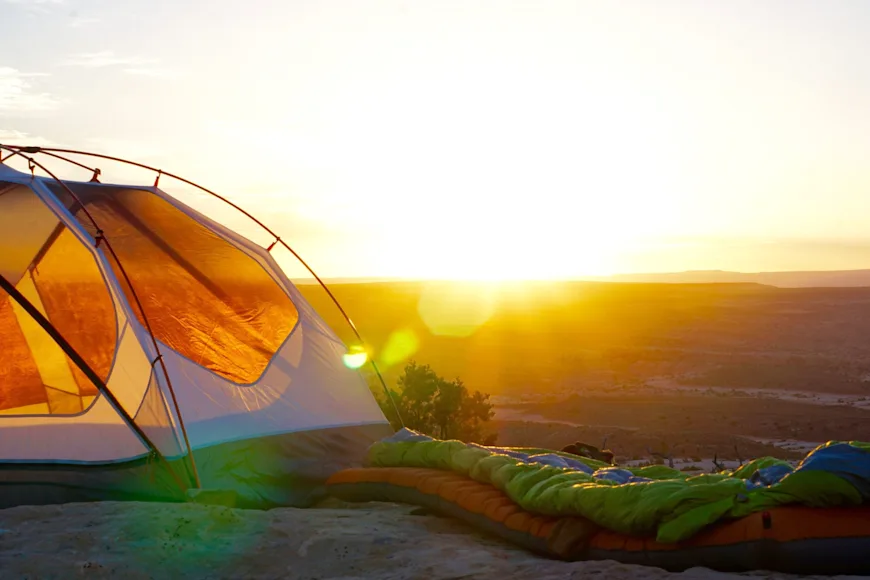_We may earn revenue from the products available on this page and participate in affiliate programs. Learn more ›
_
Best Overall

Sierra Designs Two-Person Airbed
LEARN MORE
Summary
This is a fantastic all-around buy with durable materials, a comfortable design, and a budget-friendly price.
Best for Backpacking

Therm-a-Rest Mondoking 3D Air Mattress
LEARN MORE
Summary
You can take the comfort of a bed onto the trail with this air mattress, which offers plenty of cushion for a good night’s sleep.
Best for Couples

Sea to Summit Comfort Deluxe
LEARN MORE
Summary
This extra large air mattress provides a portable and comfortable sleeping experience for couples while camping.
The best air mattress for camping will be the one that best fits your outdoor needs and personal preferences. Some of us sleep cold. Some of us might need a longer or wider mattress. Maybe you want a mattress that fits perfectly in the back of a vehicle so you can forgo a tent.
Whatever the adventure, there is an air mattress that fits the bill. It is tempting to hop over to the closest big-box store and grab whatever is cheapest. If you do that though, get ready for it to deflate on your first trip outside.
Not all air mattresses are designed for camping. You want one that is durable enough to withstand a night in a tent and can easily be inflated away from an outlet. There’s a lot to consider when shopping for the best air mattress for camping, so read on to find out how to choose the best fit for you.
Best Overall: Sierra Designs Two-Person Airbed
Best for Car Camping: Luno Air Mattress 2.0
Best for Backpacking: Therm-a-Rest Mondoking 3D Air Mattress
Best for Couples: Sea to Summit Comfort Deluxe
Best Full Sized: KingCamp 5.9” Thick Self-Inflating Sleeping Pad
How We Made Our Picks
While backpacking may be my favorite form of camping, car camping, cross country travel, or glamping are also awesome activities. Bringing an air mattress provides next-level comfort when out on these types of ventures where weight is not an issue.
To help you avoid having to buy a new air mattress every time you go camping because it inevitably leaks, I wanted to help you invest in quality mattresses designed specifically for outdoor experiences. To do this, I followed many of the considerations listed in the buying considerations section, but also evaluated:
Product Longevity: Durability is essential for outdoor products, especially sleeping pads or air mattresses. Beyond how long the mattress is projected to last, consider the warranty and if there is a repair policy. General maintenance and repair information should be accessible on the manufacturer’s website.
Product Lifecycle: It’s near impossible to avoid synthetic materials when it comes to air mattresses, but you can avoid materials known to be more toxic to people and the environment. I chose to avoid PVC materials because of this.
Customer Service: No matter the quality of the air mattress, manufacturer errors are bound to occur from time to time. How easy it is to get a hold of a customer service representative is an essential part of customer satisfaction and should always be considered.
Beyond those factors, other things that influenced my top picks for the best air mattress for camping include firsthand experience with some products, verified customer reviews, and company-specific research.
The Best Air Mattresses for Camping: Reviews & Recommendations
Best Overall: Sierra Designs Two-Person Airbed
Best Overall

Why It Made The Cut: The Sierra Designs Two-Person Airbed is a fantastic all-around buy with durable materials, a comfortable design, and a budget-friendly price.
Key Features
Dimensions: 77.9″ × 55.9″ × 10.2″
Weight: 6.11 lbs
Materials: Thermoplastic Polyurethane (TPU)
Pros
Made from durable TPU materials
Battery operated pump to inflate and deflate
Built in headrest to eliminate need for pillows
Cons
Slightly smaller than a regular queen mattress
The Sierra Designs Two-Person Airbed can comfortably fit two average adults. It has a lower profile design, making it easier to travel with than other types of air mattress designs. Although slightly smaller than a regular queen-sized mattress, it is still quite comfortable.
It can be a little noisy if you don’t inflate it enough and shift a lot in your sleep. When adequately inflated using the battery-operated inflation device, it doesn’t make much noise. The electric inflation system that comes with the bed does not come with batteries, and it is advised to pack extras to ensure you can inflate and deflate the bed fully.
The bed is designed with a built-in headrest that cuts down your packing list since you don’t need to bring camping pillows along. Although this bed is an excellent option for camping, it works best for warm weather camping as it doesn’t have the best overall insulation. If you use this for camping in shoulder seasons or colder climates, this is easy to remedy by adding a foam topper.
Best for Car Camping: Luno Air Mattress 2.0
Best for Car Camping

Why It Made The Cut: If you are on the road or prefer to sleep in your car instead of a tent, then the Luno Air Mattress 2.0 can be tailored to fit your vehicle’s make and model perfectly.
Key Features
Dimensions: Tailored to your vehicle
Weight: 15 lbs
Materials: 300D Oxford Fabric
Pros
Tailored to fit your vehicle
Made with durable and reinforced fabrics
Base extenders that fit in footwells give you more sleeping space
Cons
Can be difficult to deflate and repack into carrying bag
Car and SUV campers can rejoice with the innovative Luno Air Mattress 2.0 design! We can’t provide specific dimensions on this air mattress because it is tailored to fit your vehicle’s make and model specifications. Overall, it can usually sleep someone 6’2” and has an inflated height of 4”.
The mattress can be used for one person, a person and a dog, or two people. There is a base extender that inflates and fits down into the footwells of your vehicle to give you more room to stretch out when sleeping in the back of a vehicle. With the two separate inflatable sides, you can use it solo or inflate both sides to your desired firmness.
There are very few complaints we can list about this air mattress. It can sometimes be challenging to deflate, and some users may struggle to fit it back into the carrying case. The weight limit of the mattress is listed at 300 lbs, and users heavier than this weight have noticed that when they shift at night, they can bump the valve and cause a leak during the night.
Check to ensure that your vehicle’s back seats lay flat when folded down. The Luno Air Mattress can still work, but it won’t be as comfortable when you can’t lay completely flat.
Best for Backpacking: Therm-a-rest Mondoking 3D Air Mattress
Best for Backpacking

Why It Made The Cut: The Therm-a-Rest Mondoking 3D Self-Inflating Air Mattress brings the comfort of a bed onto the trail.
Key Features
Dimensions: 77″ × 25″ × 4″
Weight: 4.4 lbs
Materials: Non-stick 50D Polyester
Pros
Excellent warmth to weight balance
Self-inflating but also has valves for other inflation methods
Other sizes available for taller individuals
Cons
Heavy to carry for long distance hikes, but could work for overnights or weekends
We decided not to list a standard inflatable sleeping pad for this, and instead, we listed the Therm-a-rest Mondoking 3D Self-Inflating Air Mattress. It weighs just over 4 pounds, making it light enough to carry on short treks but a little too heavy to bring on any extended trips. For campers that are looking for more comfort and are okay with carrying a little extra weight, we think it is worth it.
It has a self-inflating feature, but it takes some time to inflate. If you are bringing this car camping, investing in an electric pump can save you some time, and there is a valve that supports various inflation methods.
The older models of this air mattress have 4” thick sidewalls, while the newer ones have 4.5” sidewalls. Any of the versions come in various sizes to accommodate taller individuals. The polyester is very durable and is relatively puncture resistant. Keep in mind that it can still be punctured, so carrying a repair kit is advised. When choosing a campsite, clear the sleeping area of rocks and sticks that could puncture your air mattress.
Best for Couples: Sea to Summit Comfort Deluxe
Best for Couples

Why It Made The Cut: The Sea to Summit Comfort Deluxe really brings deluxe comfort to the outdoors with a spacious size and durable cushion.
Key Features
Dimensions: 51″ x 79″ x 4″
Weight: 9 lbs 13 oz
Materials: 30D polyester upper, 75D polyester base
Pros
Durable materials
Lifetime warranty
Comfortable cushioning
Ideal warmth and insulation
Cons
Valve design isn’t straightforward
If you love camping with your partner, you need a roomy, warm, and durable air mattress. The Sea to Summit Comfort Deluxe is a relatively portable air mattress with a lifetime warranty. Although it isn’t small or lightweight enough for a backpacking trip, it is a great addition to a car camping setup or canoe camping. The mattress is large enough for most couples. Even though it is only 4 inches thick, it provides superior comfort and insulation while sleeping outdoors in most temperatures (R rating of 6.5).
The overall convenience of the sleeping pad is decent, even though the inflation valve can be a little confusing to figure out at first. It is a self-inflating mattress, and the first time it is used or after an extended storage period, it can take over an hour or more to inflate on its own. We recommend testing out the inflation before your trip to ensure the valve is functioning and that you understand how it works. Plus, the second inflation should take less time, which is ideal when you’re getting camp set up.
Best Full Sized: KingCamp 5.9” Thick Self-Inflating Sleeping Pad
Best Full Sized

Why It Made The Cut: The KingCamp Self-Inflating Sleeping Pad is a comfortable, durable, and portable air mattress designed for outdoor use.
Key Features
Dimensions: 79” x 50” x 5.9”
Weight: 13.7 lbs
Materials: 30D Polyester Fabric with TPU Coating
Pros
Self-inflating mattress that actually inflates quickly and easily
Can fit in most three-person tents
Insulated sponge filling for added warmth
Cons
Not very thick
Slightly smaller than a standard full mattress
The KingCamp 5.9” Thick Self-Inflating Sleeping Pad is an excellent choice for campers that want a comfortable mattress that can still fit within a three-person tent. It is slightly smaller than a standard full-sized mattress, but it can still sleep two average adults. There is only one size option available, so be mindful of the dimensions to ensure it will fit your body and tent.
The self-inflating design removes the need to carry around an inflation system. While these can often take a while to work, this model seems to work quite well and is very easy to inflate to the desired firmness.
It is made from a durable polyester material with a TPU coating that helps the mattress be more water-resistant. Although it isn’t as thick as other air mattresses, it does have an intentional open-cell foam insulation to keep you warm while you sleep.
Things to Consider Before Buying an Air Mattress for Camping
Type and Intended Use
How you plan on using the air mattress will greatly influence the type you decide to buy. Consider the kind of camping you are going to do. Do you need a mattress that fits in a truck bed or the back of your car? Do you want one that fits in a tent? Do you want a mattress that you can carry easily?
These questions and more can help you narrow down some of the choices. Once you’ve identified how you want to use the mattress, decide the type of mattress that will work best for you.
Types of air mattresses for camping:
Standard: This is the mattress you likely picture when you imagine an air mattress. It is six or more inches thick and can comfortably fit two adults. These will have some felt or grip on the top to keep the sleeper secure and grooves or dents to distribute weight when inflated. There are other sizes within a standard air bed design, but the features tend to be the same.
All-In-One: These are unique to camping air beds, as they come with the sleeping bag attached to the mattress itself. The intention behind this is to make it easier to transport, set up, and to prevent bedding or bags from moving around while you sleep.
Double Height: Great for campers that want to be further off the ground, double-height beds are what they sound like– they’re double the height or more of standard air beds. These tend to be equally as comfortable, but provide more distance from the ground, making them feel more like a real bed. You can also group air mattress and cot combos into this category.
Inflatable Sleeping Pad: These are either self-inflating, you blow them up, or a pump is provided to assist you. These are primarily used for backpacking because of their small size. They are much thinner than standard air mattresses and primarily offer insulation from the ground.
Within each type of air mattress, there will be a variety of sizes available. Even with inflatable sleeping pads, they make wider and longer versions to accommodate different needs and comfort levels.
Material
The most common material you will see used for air mattresses is PVC or polyvinyl chloride. This material remains popular for air mattresses because it is less expensive to manufacture, the overall durability, waterproofing capabilities, and flexibility.
While it seems to work decently well for this application, PVC materials contain phthalates, which give off the powerful toxic odor you may associate with air beds. Many people also have allergies to this material.
Beyond that, PVC is an environmentally damaging material to produce, and it will last indefinitely. It is a petroleum-based material, meaning it is made from fossil fuels, and because it is plastic, it never fully biodegrades; it only breaks down into smaller pieces.
If allergies or environmental concerns make you shy away from PVC materials, there are other options, though they tend to be harder to find.
Another relatively common material used for air mattresses is TPU or thermoplastic polyurethane. Although this is still a type of plastic, TPU does not require any toxic chemical treatment before use. Because of this, it tends to be more allergen-friendly and slightly more environmentally responsible.
TPU is still highly durable and tends to be considered a somewhat easier material to recycle. Another material listing you may see is polyester with a TPU coating. PVC, TPU, and polyester are all petroleum-based materials.
Many air mattresses, especially those used for camping, will be reinforced with quilted textiles or made with some vulcanized rubber to make them more durable and puncture-resistant. The covers of many air mattresses may also include varying materials as they are textured to prevent slipping or help with heat retention.
Other great additions to look for in the best air mattresses for camping include antimicrobial and waterproof covers that help keep the bed clean and dry when you’re outside.
Size and Weight
The size and weight of the air mattress you choose will largely depend on the intended use. If you are looking for an air mattress for car camping versus one for backpacking, weight may not matter much.
If you only camp in areas accessible by car, weight likely will only be an issue if you are limited on space or don’t like carrying more than a certain amount of weight. Always check to ensure that the weight and packed size suit your travel needs.
Beyond the weight, consider the size of the surface area when inflated and the height. The surface area is important not only to determine if your body will fit on it but also if it will work in the tent or car you plan to use. They make single or twin air mattresses, but those tend to be less common than full, queen, or king sizes.
The air mattress dimensions should be smaller than the floor of your tent. This not only allows for you to have some floor space for gear, but when things are pushed up against the walls to tents, moisture can easily enter the tent despite any waterproofing.
Air mattress sizes are often the same as regular bed sizes:
Twin: 38” x 74”
Twin XL: 38” x 80” (XL = extra long)
Full: 54” x 74”
Queen: 60” x 80”
King: 76” x 80”
Sleeping pad sizes will differ in comparison to air mattresses, and some camping-specific air mattresses may also have variations in sizing. Always check the product description to ensure the size is to your specifications.
Inflation Method
Air mattresses all require some method of inflation. Many air beds on the market are sold with an inflation device, and if they aren’t, you can buy those separately. For smaller inflatable camping pads, you can inflate those using your mouth or the compact air bags often provided.
However, there is a lot more to fill with air mattresses, and blowing into it will simply not cut it. The choice then comes down to manual or electric pumps, and there are variations within them.
Types of pumps for air beds:
Electric pump requiring a power source outlet
Electric pump with rechargeable battery
Battery-powered electric pumps (non-rechargeable batteries)
Self-inflating air mattress
Manual foot pump
Manual hand pump
Valves to inflate the mattress will either be internal or external and because of the variations in types of pumps, they may have adaptors to accommodate different designs.
Most internal pump systems will utilize electric pumps or will be self-inflating. External pumps most often require a manual pump or can use either type of electric pump. Self-inflating mattresses sometimes require slight assistance from a pump or by blowing into it, but it should be minimal.
Internal pumps tend to be more expensive and are more likely to have flaws or malfunction. The perk of internal pumps is that they often inflate much faster, and it is much harder to lose any parts since they’re all self-contained.
On the other hand, external pumps are often more affordable and more durable. No matter the type of valve system on the mattress, electric pump systems will inflate the bed much faster. The issue with that is unless you have a battery-powered pump, then you need access to a power source.
If a manual pump is more your speed, prepare for a fair bit of effort to inflate the bed. These pumps are often more compact, and you don’t have to worry about running out of battery or having a power source. Foot pumps tend to be easier to use and less tiring than hand pumps.
Another consideration when looking at inflation options is to notice whether or not it is a “never flat” or dual pump or valve. These are mattresses that require a pump to not only inflate the bed but also deflate the bed. This way, you’re not racing to shut the valve once you disconnect the pump, and it is far less likely to leak out air as you sleep.
R-Value
Comfort is primarily why many campers seek out an air mattress. Just like the best sleeping bags, air mattresses for camping should be as warm as they are comfortable. An air mattress can help you stay warm at night by insulating you from the cold ground. How well it does that will vary from bed to bed. To tell how warm it will be, you can look at the R-Value.
As a general rule, the higher the R-Value of a mattress or sleeping pad, the better it will be at insulating and retaining heat. You’ll most likely see a range of 1-10 (1 being the lowest and ten being the highest).
If you’ve slept on an air mattress before and gotten cold, this is likely because they had a low R-Value. Heat dissipation can occur due to trapped air. The best air mattresses for camping will be designed with a baffle or padded layer to prevent heat loss and increase comfort.
Air mattresses with internal structures and designs intended to retain heat will include chambers or coil systems. These internal structures slow down air movement and slow down any cold air currents.
Unfortunately, it is hard to rely solely on the R-Value when looking at different brands of air mattresses to help you determine the heat retention capabilities. This is because how brands determine the R-Value differs from brand to brand. So, looking at the R-Value and other structural components that contribute to heat retention is helpful.
FAQs
Q: Which air mattress is most durable?
The most durable air mattresses are often made from polyester or TPU material with reinforcing fabric to protect them from the elements, along with rocks, sticks, and dog paws. PVC is similarly durable to TPU materials but emits a toxic chemical odor and is harder to recycle.
Q: How long can an air mattress last?
How long an air mattress lasts will depend on how frequently it is used, how well it is maintained, and if it is stored properly. Air mattresses used only on occasion can last anywhere from eight to 10 years, sometimes longer if able to be repaired.
Q: How can I make my air mattress as comfortable as possible?
Make your air mattress as comfortable as possible by investing in a high-quality mattress with appropriate heat retention for your needs. Most people complain of discomfort when sleeping on air mattresses because they get cold. If this is the case with your current mattress, you can add a topper, use more bedding, and ensure it is staying inflated.
Final Thoughts on the Best Air Mattresses for Camping
The best air mattress for camping will be different from the air mattress you typically use for guests at home. To have a reliable and comfortable sleeping experience during your entire camping trip, you need a mattress durable enough to be used outdoors. Consider outdoor-specific mattresses that take insulation, inflatability, and durability into account when designing their products.
Why Trust Us
For more than 125 years, Field & Stream has been providing readers with honest and authentic coverage of outdoor gear. Our writers and editors eat, sleep, and breathe the outdoors, and that passion comes through in our product reviews. You can count on F&S to keep you up to date on the best new gear. And when we write about a product—whether it’s a bass lure or a backpack—we cover the good and the bad, so you know exactly what to expect before you decide to make a purchase.






